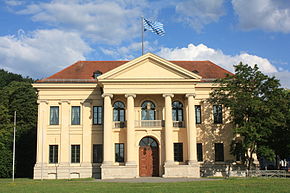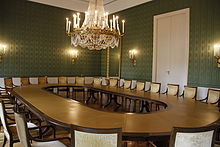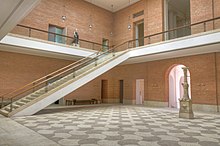Prince Carl Palais
The Prinz-Carl-Palais is an early classical palace in Munich . It is the official seat (not the residence) of the Bavarian Prime Minister , but has only been used by the state government for representational purposes since the new building of the Bavarian State Chancellery was moved into in 1993 .
location
The Prinz-Carl-Palais (Franz-Josef-Strauss-Ring 5) is located east of the financial garden between the Hofgarten and the English Garden . It forms the optical start of Prinzregentenstrasse .
history
The from Lorraine originating commendatory abbot of the Benedictine Abbey of St. Mauritius in Tholey , Pierre de Salabert , educators Elector Max IV. Joseph, later King Max I. Joseph , acquired in extensive dimensions Standard at the former Wall mount which of the facility later enabled the so-called financial garden. In March 1803, the only 21-year-old Karl von Fischer was commissioned to plan the palace. Karl von Fischer had to reduce the first elaborated design considerably while retaining the representative main facade: a complex of the main wing and a short left wing at the rear remained. The foundation stone was laid on May 24, 1804; the palace was occupied in August 1806. After Pierre de Salabert died in 1807, King Max I Joseph acquired the building, which was now called the Palais Royal or Pavillon Royal . Shortly after his accession to the throne, King Ludwig I transferred it to his brother, Prince Carl , on November 14, 1825 , who had the palace expanded considerably by Jean Baptiste Métivier . The main rooms were redecorated from 1827 to 1830 by Jean-Baptiste Métevier and Anton Schwanthaler. After his death in 1876, the palace became the seat of the Austro-Hungarian legation , which it remained until 1919. Although Bavaria repeatedly asked for the re-establishment of an Austrian embassy in Munich in the first few years after the war, Vienna did not respond to this request out of consideration for the interests of the German government and the Allies. In 1924 the palace was designated as the official residence of the Bavarian Prime Minister .

After the DC circuit and lifting of the Bavarian State Government by the Nazi rulers it was used as headquarters of the Reich Governor of Epp used. In 1937 the Prinz-Carl-Palais was extensively converted into a guest house by Fritz Gablonsky . The occasion was an upcoming visit by Benito Mussolini . The palace was extended considerably to the west; the north wing of Métiviers, which was demolished because of the simultaneous widening of Von-der-Tann-Strasse, was replaced by a new one based on plans by Fritz Gablonsky, which were modeled on the south wing.
The Prinz-Carl-Palais survived the air raids on Munich in World War II with little damage. In 1948 it became the seat of the newly founded Bavarian Academy of Fine Arts . In addition, from 1967 the palace was used as an emergency quarter for the Glyptothek and the State Collections of Antiquities . The Prinz-Carl-Palais has been the official seat of the Bavarian Prime Minister since 1968, but not as an apartment and only for representative purposes. When the Altstadtring Tunnel was built in 1970, the basement rooms had to be demolished for the underpinning with a reinforced concrete slab of the tunnel; since then the Prinz-Carl-Palais has been standing on the ceiling of the Altstadtringtunnel.
In the years 1971–1975 the Landbauamt München restored and rebuilt the palace for around 87 million DM. The garden front was moved forward slightly and a central two-storey reception hall in modern shapes with stairs, gallery and skylight was added. The walls of the hall are made of hand-cut bricks. The palace was used by the Prime Minister and the head of the State Chancellery. The meetings of the Council of Ministers (cabinet) also took place here.
After the completion of the new Bavarian State Chancellery in 1993, the Prime Minister finally moved into the new building with his employees. Since then, the use of the palace has been limited to representation purposes. The Prinz-Carl-Palais is reserved for the Prime Minister, even ministers do not have the opportunity to hold events in the house. One of the few opportunities to visit the building was the State Chancellery's Open Day, which took place every year in June until 2010.
Appreciation
The Prinz-Carl-Palais is a prime example of Munich's early classicism . In the old building, the classicist interior design - especially panel parquet, carved panel doors, stucco decor and rich decorative painting on the mirror ceilings - has largely been preserved. Most of it is probably due to Métivier. The rectangular ballroom on the upper floor and the white and blue "Prime Minister's Room" are among the most important palace interiors in Munich.
In the interior of the palace there are pictures from the Greece cycle by Carl Rottmann (1797–1850), which was commissioned by Ludwig I and is considered Rottmann's main work. You can see "Sikyon with Corinth" (Greece cycle No. 18), "Eleusis" (No. 22), "The Lion Gate of Mycenae" (No. 2) and "Olympia" (No. 16). On the ground floor there is a marble candelabra from the Roman Empire. A statue of Flora made of Carrara marble ( Pietro Tenerani , 1789–1869, Rome) and the Nyx made of white and black marble can be found on the upper floor .
literature
- Fred Angerer, Herbert Jensen, Karl-Heinz Schaechterle: Munich, expert opinion for the area of the Prinz-Carl-Palais . Technical University, Munich 1967.
- Inge Feuchtmayr: The Prinz-Carl-Palais in Munich. Figures and events . Süddeutscher Verlag, Munich 1966.
- Klaus Gallas : Munich. From the Guelph foundation of Henry the Lion to the present: art, culture, history . DuMont, Cologne 1979, ISBN 3-7701-1094-3 (DuMont documents: DuMont art travel guide).
- Christine Götz, Elfi M. Haller: Prinz-Carl-Palais. From the Palais Salabert to the seat of the Bavarian Prime Minister . Bayerische Vereinsbank, Munich 1989.
- Heinrich Habel u. Lothar Altmann: Once an elegant villa - Das Prinz-Carl-Palais, in: Die Bayerische Staatskanzlei, 10th edition, Regensburg 2013, pp. 35–39.
- Johannes Merz: Prinz-Carl-Palais, Munich , published on August 29, 2006; in: Historical Lexicon of Bavaria
See also
Web links
- Prinz-Carl-Palais - Interactive 360 ° panorama
- muenchen.de: Prinz-Carl-Palais
- Johannes Merz: Prinz-Carl-Palais, Munich in: Historisches Lexikon Bayerns
Individual evidence
- ^ Johannes Merz: Prinz-Carl-Palais, Munich. In: Historical Lexicon of Bavaria. August 29, 2006, accessed on January 7, 2017 (German).
- ^ The Benedictine Abbey of St. Mauritius zu Tholey, Rheinische Kunststätten, issue 321, Neuss 1987.
- ^ The Benedictine Abbey Tholey, in: Dieter Staerk (Ed.): Das Saarlandbuch, 5th edition, Saarbrücken 1990.
- ↑ historisches-lexikon-bayerns.de (Foreign legations in Munich)
- ^ Johannes Merz: Prinz-Carl-Palais, Munich , published on August 29, 2006; in: Historisches Lexikon Bayerns, online , accessed on June 16, 2018.
Coordinates: 48 ° 8 ′ 39 ″ N , 11 ° 34 ′ 59 ″ E






